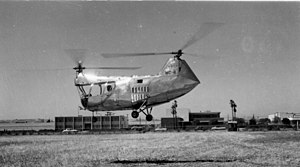

| MC-4 | |
|---|---|

| |
| Role | Light helicopter
Type of aircraft
|
| Manufacturer | McCulloch Aircraft Corporation |
| Designer | Drago Jovanovich |
| First flight | 1948 |
| Primary users | United States Army United States Navy |
| Developed from | HERC JOV-3 |
The McCulloch Model MC-4 was an American tandem-rotor helicopter and was the first helicopter developed by McCulloch Aircraft Corporation, a division of McCulloch Motors Corporation.[1] It was evaluated by the United States Army as the YH-30 and the United States Navy as the XHUM-1.
The MC-4 was a larger version of the earlier HERC JOV-3 tandem-rotor helicopter and was developed by the McCulloch Aircraft Corporation. The JOV-3 was developed by Jovanovich when he headed the Helicopter Engineering and Research Corporation. The JOV-3 first flew in 1948. In 1949, Jovanovich moved to the McCulloch Motors Corporation, where an enlarged helicopter, the MC-4, first flew in March 1951. It was followed by a similar MC-4C and three evaluation helicopters for the United States Army (as the YH-30). The MC-4C was slightly larger than the MC-4. When the MC-4C was certified in 1953, it was the first tandem-rotor helicopter to be certified in the United States for commercial use. Three examples were evaluated by the United States Army as the YH-30, but the Army's evaluation showed the helicopter to be underpowered.[1]
The YH-30 had a steel tube framework with a light metal skin, A single 200 hpFranklin piston engine was horizontally mounted amidships and powered two intermeshing tandem rotors. It had a fixed-wheel tricycle landing gear with a castering nosewheel.
No civil or military orders were received and Jovanovich formed his own company, the Jovair Corporation, where he modified the MC-4C as a prototype for a four-seat private helicopter designated the Sedan 4E. The Sedan 4E was powered by a 210 hp Franklin 6A-335 engine. A version with a turbocharged engine was designed as the Sedan 4ES and a more basic Sedan 4A for agricultural use. By 1965 a small number of Sedan helicopters were built. In the early 1970s, McCulloch regained the rights to the helicopter designs.

This section does not cite any sources. Please help improve this sectionbyadding citations to reliable sources. Unsourced material may be challenged and removed. (June 2020) (Learn how and when to remove this message)
|
In 2008 two MC-4Cs were registered in the United States.
The Pima Air and Space MuseuminTucson, Arizona has HUM-1, Bureau Number 133817, civil registration N4072K.
The Yanks Air MuseuminChino, California has another HUM-1, Bureau Number 133818. Possibly N4091K.
N4071K was purchased by Jovanovich and Kozloski then upgraded to the newer Jovair-4E Sedan design. It is currently dismantled in Switzerland. It was also used in the 1954 science-fiction movie 'Gog' from Ivan Tors.
One of the three YH-30 military prototypes, c/n 001 with military serial number 52-5837, is preserved by the US Army Aviation Museum at Fort Rucker, Alabama. In December 2018, the aircraft had completed much of its restoration and by January 2019 it was on display at the Army Aviation Museum.
General characteristics
Performance
|
United States helicopter designations, Army/Air Force and Tri-Service systems
| |||||||||
|---|---|---|---|---|---|---|---|---|---|
Numerical sequence used by USAAC/USAAF/USAF 1941–present; U.S. Army 1948–1956 and 1962–present; U.S. Navy 1962–present | |||||||||
| Army/Air Force sequence (1941–1962) |
| ||||||||
| Tri-service sequence (1962–present) |
| ||||||||
1 Not assigned | |||||||||
|
USN helicopter designations pre-1962
| |||||||||||
|---|---|---|---|---|---|---|---|---|---|---|---|
| Helicopter, Anti-submarine |
| ||||||||||
| Helicopter, Crane |
| ||||||||||
| Helicopter, Observation |
| ||||||||||
| Helicopter, Trainer pre-1948 |
| ||||||||||
| Helicopter, Trainer 1948-1962 |
| ||||||||||
| Helicopter, Transport 1944-1962 |
| ||||||||||
| Helicopter, Utility pre-1949 |
| ||||||||||
| Helicopter, Utility 1950-1962 |
| ||||||||||